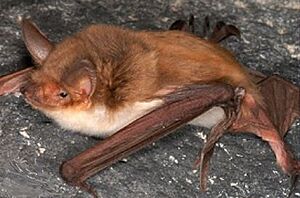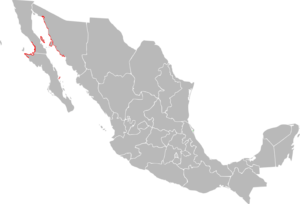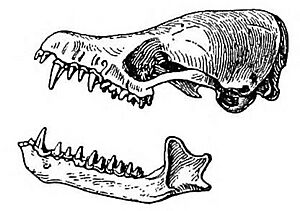Fish-eating bat facts for kids
Quick facts for kids Fish-eating bat |
|
|---|---|
 |
|
| Conservation status | |
| Scientific classification | |
| Genus: |
Myotis
|
| Species: |
vivesi
|
 |
|
The Myotis vivesi, also known as the fish-eating bat, is a special kind of bat. It lives near the Gulf of California and loves to eat fish and small crustaceans. This bat is the biggest Myotis species found in the Americas. It has super large feet, which help it catch its food! A scientist named Auguste Ménégaux first described this bat in 1901.
What Does This Bat Look Like?
The Myotis vivesi is the largest Myotis bat in the Americas. It's about the same size as the greater mouse-eared bat found in Europe and Asia. Its skull is usually about 23 millimeters (almost an inch) long.
One of the most amazing things about this bat is its feet! They are extra long, about 23 millimeters. This is much longer than the feet of other similar bats. These big feet with sharp claws are perfect for catching slippery fish.
This bat also has long, strong wings. These wings are great for flying efficiently over water. The skin between its hind legs, called the uropatagium, has a fringe of silky hairs. This part of the wing is also used when the bat hunts.
The bat's fur is about 8 millimeters long. It can be light brown or a darker brown. The base of each hair is dark gray. Like other fish-eating bats, the Myotis vivesi's belly is a pale color.
Where Does the Fish-Eating Bat Live?
The Myotis vivesi lives along the coast of the Gulf of California in Mexico. You can find it in the states of Sonora, Baja California, and Baja California Sur. It mostly lives on small islands.
There's also a small group on the Pacific coast of the Baja California peninsula. Even though it lives on many separate islands, these bats still seem to mix and share their genes. This means they are not isolated from each other.
How Does This Bat Live?
The Myotis vivesi mainly eats ocean fish and crustaceans. This includes a type of crab called the squat lobster. Only one other bat, the greater bulldog bat, hunts in the ocean.
You can tell what the bat has eaten by looking at its droppings, called guano. If the guano is red, it ate crustaceans. If it's black, it ate fish. Green guano means it ate algae, and brown means it ate insects. Yes, sometimes it eats insects too!
These bats can fly very far to find food. In 1970, scientists saw about 400 Myotis vivesi bats around a boat. The boat was at least 7 kilometers (4.3 miles) away from the shore!
The Myotis vivesi lives in a dry environment. It has learned to make its urine very concentrated. This special ability allows it to drink seawater to survive!
Where Do They Sleep?
Myotis vivesi bats like to sleep, or roost, in caves. They also roost under rocks that have fallen from landslides. Sometimes, they share their roosts with small seabirds. These birds are called least petrels and black petrels.
On many islands, lizards called western whiptails try to eat the petrels' eggs and chicks. The petrels are usually scared of these lizards and can't do much to protect their babies. But when Myotis vivesi bats share a roost, they help! If a lizard comes near, the bats quickly bite and flap their wings. This scares the lizards away. This is a great example of a symbiotic relationship. The bats help protect the young petrels, which helps more petrel chicks survive.
How Scientists Study This Bat
Auguste Ménégaux first described the Myotis vivesi in 1901. Later, another scientist tried to put it in its own group called Pizonyx. But now, scientists usually include it back in the Myotis group.
We don't know exactly why Ménégaux chose the name vivesi. It might be named after a person called Vives, or it could come from the Latin word vivere, which means "to live."
The Myotis vivesi's closest relatives are other Myotis bats from the Americas. These relatives don't eat fish. This means that the ability to catch fish probably developed separately in different bat species. This is called convergent evolution.
Scientists haven't found any fossils of the Myotis vivesi yet.



